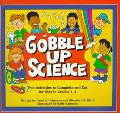

 |

|

The average rating for Gobble Up Science Fun Activities to Complete and Eat based on 2 reviews is 3.5 stars.
Review # 1 was written on 2016-10-19 00:00:00 Sorial Mark Sorial MarkThis was Merton's doctoral dissertation. Two things to be said about it: First, this work is most famous, or notorious, for its suggestion that the culture/worldview/ethic of Puritanism (Calvinism) facilitated the emergence of modern science. Readers who go back to this, the original text, will see that the hypothesis is framed very modestly, and that religion is only one of several contextual social factors examined. Second, this pioneering sociologist's mastery of primary source material from the seventeenth century is truly astonishing. He would have made a first-rate historian if he had chosen that field, and the wealth of facts at his fingertips from his readings across centuries of scientific history informed his theoretical sociological work to great advantage, as his readers know. The writings of later generations of sociologists with more narrow disciplinary training seem impoverished in comparison, on the whole. |
Review # 2 was written on 2009-05-29 00:00:00 Elijah Hodges Elijah HodgesA. Preface 1970 1. The main sociological idea is that social behavior in one sphere (religion & economics) is interdependent with other spheres (science) 2. Use of Sartonian quantitative analysis to generate and test its conclusions B. Introduction 1. At various points there are shifts in interest from one science to another 2. In 17th England it provides a good study for the shifts and foci of interest in S&T C. Social Background: Shifts in vocational interest 1. Used the dictionary of national biography 2. Ex. Army & Navy increased during Civil Wars 3. Scientists peaked during formation of the Royal Society D. Foci & Shifts of Interest in Science and Technology 1. Science increased because of Royal Society and the cessation of civil disturbance 2. Each science peaks at different times. a) Intrinsic: Ex. Chemistry decreases slightly after Boyles death b) External: Social values also played a role E. Puritan and Cultural Values 1. The growth of science in the 17th had its roots in its culture 2. Religion was a dominating cultural force in the 17th 3. "Glorification of God" was the main Protestant emphasis and puritans a) Reason was held in high regard because man was blessed with it b) Education emphasized reason (math and physics), literature, art, philosophy were time wasting self-indulgence c) Physics was the most important because it allowed man to explore God's works F. Motive Forces of the New Science 1. Science began a new life apart from the Puritans 2. This was fueled by the amateurs. Ex. Boyle 3. The secularization of science was underway G. Puritanism, Pietism, and Science: Testing an Hypothesis 1. Discussion of the strong Puritan influence in the founding of the Royal Society 2. Statistics prove that Protestants preferred science over Catholics 3. This was confirmed by the number of scientists who claimed to be Protestant v. Catholic H. Science, Technology and Economic Development: Mining 1. Puritanism explains the increase in scientific activity--so what explains the increase in technology and invention 2. In the 17th coal mining expands which increases mercantile marine, which inturn influences science I. Science, Technology & Economic Development: Transportation 1. A key to economic expansion is the need for better transportation and communication 2. The mercantile trading empire brings associated tech. problems a) Royal Societies main job was one of navigation. ex. how to find longitude b) This exemplifies the utilitarian role of science c) The result was Huygens theory of the Pendulum J. Science and Military technique 1. England's prolonged warfare in the 17th resulted in a change of military technique a) Fire arms replaced swords, heavy artillery in the field 2. This resulted in studies of interior ballistics (study of the formation, temperature, and volume of gasses into which the powder charge is converted by combustion) 3. Exterior ballistics (motion of projectile, velocity, trajectory, gravity) |
CAN'T FIND WHAT YOU'RE LOOKING FOR? CLICK HERE!!!